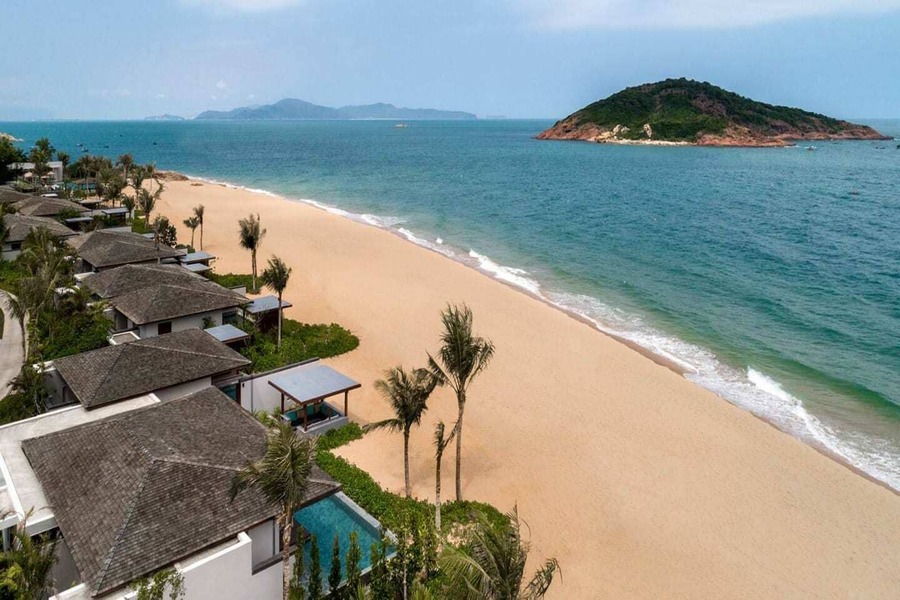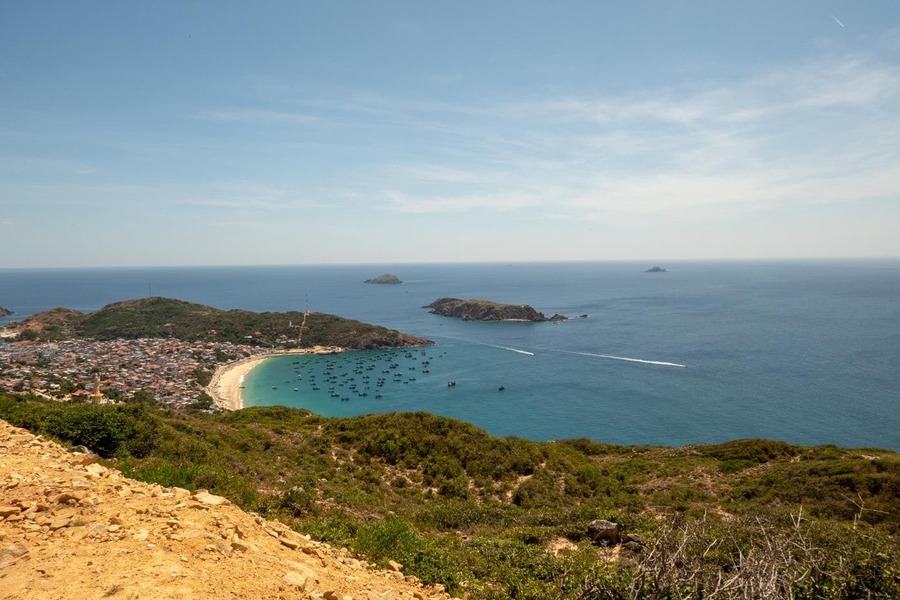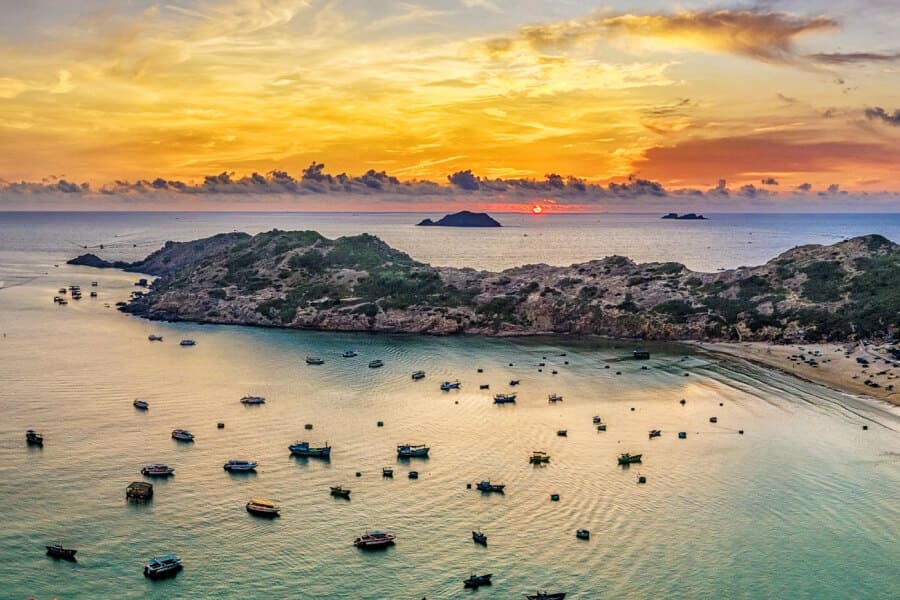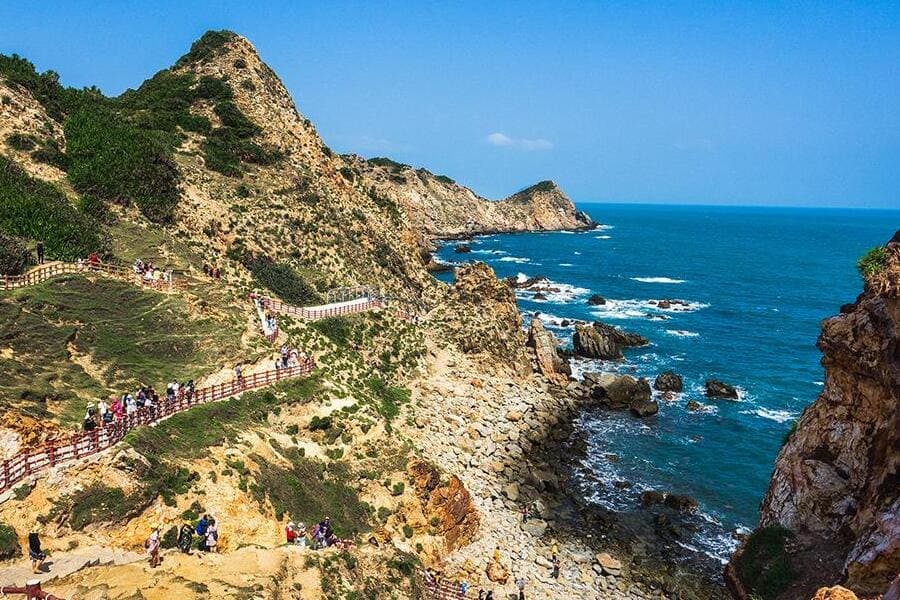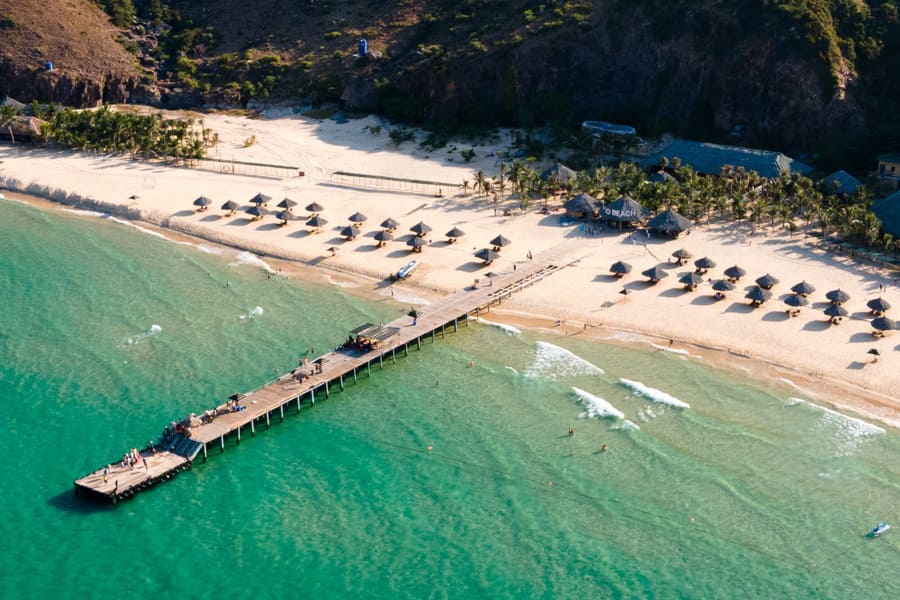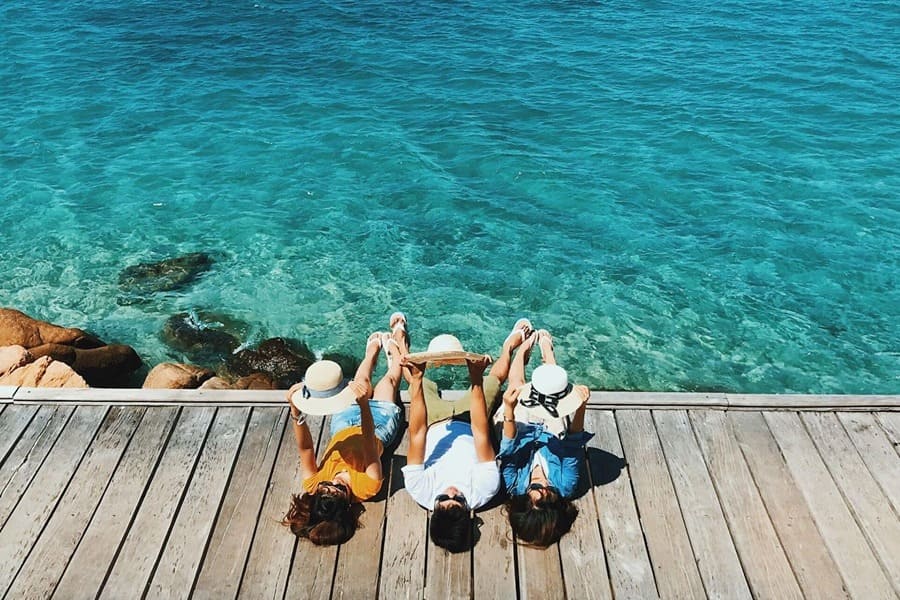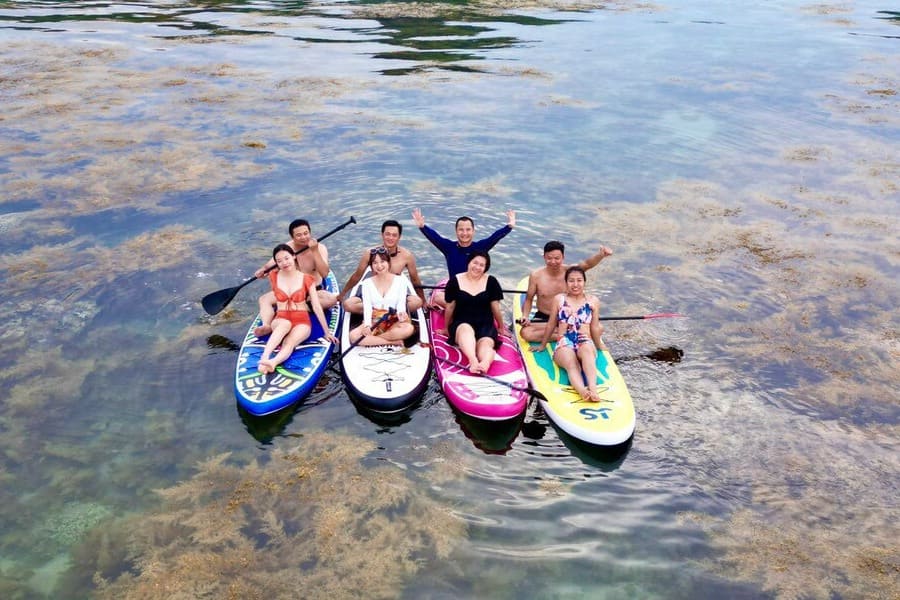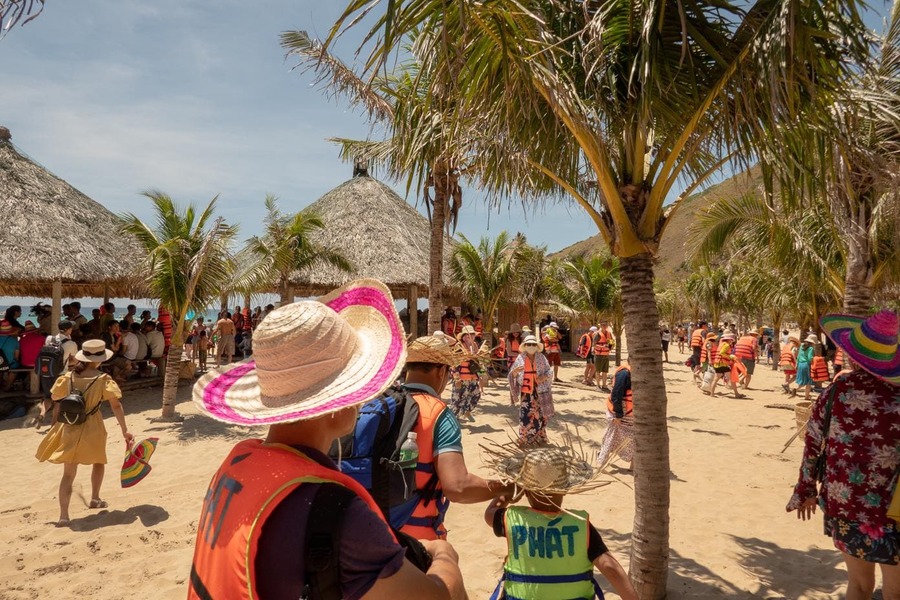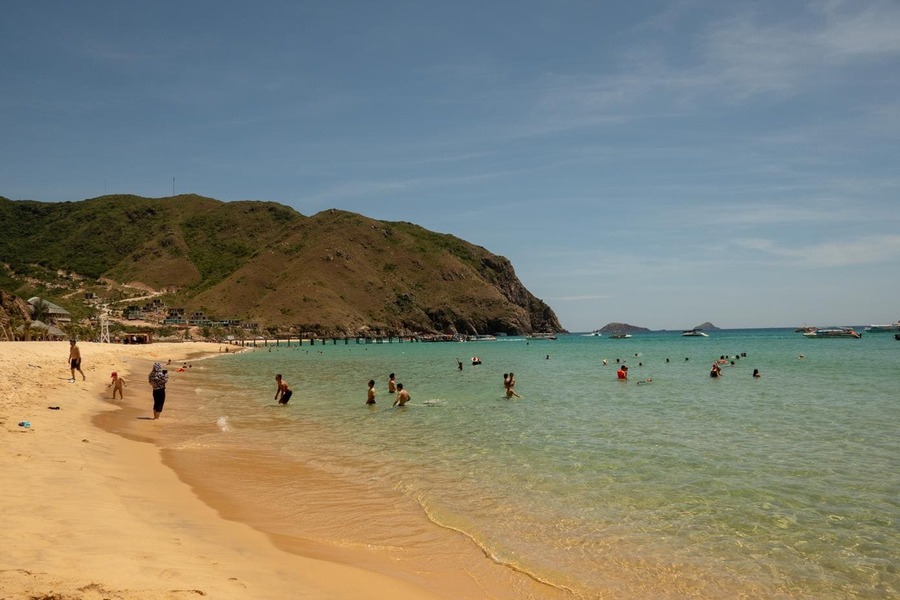Nestled along the southeastern coast of Vietnam’s Binh Dinh Province, the Gallery of Natural Arts in Phuong Mai Peninsula stands as a testament to nature’s unparalleled artistry. This scenic haven near Quy Nhon City is renowned for its breathtaking geological formations, sculpted over eons by the relentless forces of wind and sea. Towering cliffs adorned with intricate patterns and surreal shapes create an otherworldly landscape that captivates visitors and photographers to explore the marvelous Vietnam shore excursions.
About Phuong Mai Peninsula
Phuong Mai Peninsula, nestled in the coastal city of Quy Nhon, Binh Dinh Province, Vietnam, is celebrated for its natural beauty and serene ambiance. This picturesque peninsula boasts sandy beaches embraced by lush green hills and bordered by clear blue waters of the South China Sea. It offers visitors a tranquil retreat amidst stunning scenery, perfect for relaxation and leisure activities. The area is renowned for its seafood cuisine, making it a delightful destination for culinary enthusiasts. Whether strolling along its scenic coastline, enjoying water activities, or exploring its natural trails, Phuong Mai Peninsula offers a serene escape into Vietnam’s coastal charm.
The best time to visit Phuong Mai Peninsula is during the dry season, which typically spans from January to August. This period offers the most favorable weather conditions with sunny skies and minimal rainfall, making it ideal for outdoor activities such as beach walks, swimming, and exploring the peninsula’s natural beauty. Avoiding the rainy season from September to December is advisable as heavy rains can disrupt travel plans and limit outdoor enjoyment.
The gallery of heaven attractions in Phuong Mai Peninsula
Nhon Ly Beach
Nhon Ly Beach is located in Quy Nhon City, which is part of Binh Dinh Province in central Vietnam. This beach is renowned for its pristine beauty, clear waters, and tranquil atmosphere, making it a popular destination for both locals and tourists seeking a peaceful retreat. Nhon Ly Beach is situated about 25 kilometers northeast of Quy Nhon City center, making it accessible within a short drive from the city. The beach is nestled in a picturesque bay surrounded by rocky cliffs and lush greenery, adding to its natural charm.
One of the standout features of Nhon Ly Beach is its crystal-clear turquoise waters and soft sandy shores. The beach is relatively unspoiled and less crowded compared to other more famous beaches in Vietnam, offering visitors a serene environment to relax and unwind. Visitors to Nhon Ly Beach can indulge in various activities such as swimming, sunbathing, and beach games due to its calm and gentle waters. The beach is also ideal for snorkeling and diving, with opportunities to explore the diverse marine life and coral reefs just off the coast.
Aside from its natural beauty, Nhon Ly Beach is close to other attractions that visitors can explore. These include the ancient Cham towers of Banh It and Twin Towers, which are significant historical and architectural sites. Additionally, the nearby fishing village of Nhon Ly offers a glimpse into the local way of life and opportunities to enjoy fresh seafood dishes. While Nhon Ly Beach maintains a quieter atmosphere compared to more developed tourist spots, there are several accommodation options ranging from guesthouses to resorts that cater to different budgets. Basic amenities such as restaurants serving local cuisine, convenience stores, and souvenir shops are available to ensure a comfortable stay for visitors.
The best time to visit Nhon Ly Beach is during the dry season, which typically spans from February to August, when the weather is sunny and conducive for outdoor activities. It’s advisable to avoid the rainy season (September to January) due to occasional storms and rough seas. Nhon Ly Beach is a hidden gem along Vietnam’s central coast, offering natural beauty, tranquility, and opportunities for outdoor recreation. Whether you’re looking to relax on its pristine shores or explore the surrounding attractions, Nhon Ly Beach provides a memorable experience for travelers seeking a quieter alternative to more bustling beach destinations.
Eo Gio (Wind Strait)
Eo Gio, also known as Wind Strait in English, is a stunning coastal area located near Quy Nhon City in Binh Dinh Province, Vietnam. It is renowned for its breathtaking natural scenery, dramatic cliffs, and crystal-clear waters, making it a popular destination for tourists and nature enthusiasts.
Eo Gio is situated approximately 20 kilometers south of Quy Nhon City, along the coastal road that leads towards Tuy Hoa City. The name “Eo Gio” translates to “Wind Strait,” which aptly describes the area due to the strong sea breezes that often sweep through the strait between two rocky cliffs.
The primary allure of Eo Gio lies in its rugged beauty and unspoiled nature. The coastline is characterized by towering cliffs that drop dramatically into the sea, forming picturesque coves and bays. The crystal-clear waters around Eo Gio are perfect for swimming, snorkeling, and diving, offering opportunities to explore vibrant coral reefs and diverse marine life.
Visitors to Eo Gio can enjoy a range of activities amidst its stunning natural surroundings. These include hiking along the coastal trails that offer panoramic views of the South China Sea, relaxing on secluded beaches nestled among the cliffs, and capturing breathtaking sunset vistas. The area is also popular for photography enthusiasts due to its dramatic landscapes and scenic viewpoints.
In addition to its natural beauty, Eo Gio is close to other attractions that visitors can explore. These include the historic Thi Nai Bridge, which spans the Thi Nai Lagoon and connects Quy Nhon City with Phuong Mai Peninsula. The bridge offers stunning views of the lagoon and is a popular spot for sunset viewing and photography.
While Eo Gio retains a rustic charm with limited development, there are basic amenities available such as parking areas, small eateries serving local seafood dishes, and souvenir shops. The area is accessible by motorbike or car via a scenic coastal road from Quy Nhon City, making it a convenient day trip or a peaceful retreat away from the city’s hustle and bustle.
The best time to visit Eo Gio is during the dry season from February to August when the weather is sunny and the sea is calm, ideal for outdoor activities and enjoying the beach. It’s advisable to check local weather conditions, especially during the rainy season from September to January, when occasional storms may affect travel plans.
Eo Gio, or Wind Strait, is a hidden gem along Vietnam’s central coast, offering visitors a chance to experience pristine natural beauty, rugged cliffs, and tranquil beaches. Whether you’re seeking adventure, relaxation, or simply a place to connect with nature, Eo Gio promises a memorable experience amidst its picturesque landscapes and serene coastal ambiance.
Ky Co Beach
Ky Co Beach is a beautiful coastal area located near Quy Nhon City in Binh Dinh Province, Vietnam. It is renowned for its pristine white sandy beaches, clear turquoise waters, and picturesque surroundings, making it a popular destination for both locals and tourists seeking a tranquil seaside retreat.
Ky Co Beach is situated on the southeastern side of Quy Nhon City, approximately 25 kilometers from the city center. It is part of the Phuong Mai Peninsula and can be reached by boat from the nearby fishing village of Nhon Ly or by a combination of boat and trekking from the mainland.
The main attraction of Ky Co Beach lies in its natural beauty and secluded atmosphere. The beach features soft white sands that contrast beautifully with the deep blue hues of the South China Sea. The waters are clear and shallow near the shore, ideal for swimming and snorkeling, allowing visitors to observe colorful marine life and coral reefs.
Visitors to Ky Co Beach can indulge in various activities such as sunbathing on the pristine sands, swimming in the calm waters, and exploring the surrounding rocky cliffs and caves. Boat tours are available to explore nearby islands and secluded coves, providing opportunities for snorkeling and sightseeing.
One of the highlights of visiting Ky Co Beach is the panoramic views it offers from its elevated vantage points. Visitors can hike up to Ky Co Hill or climb the nearby rocky cliffs to enjoy breathtaking views of the coastline, the azure sea stretching out to the horizon, and the lush greenery of the peninsula.
While Ky Co Beach retains a natural and undeveloped charm, basic facilities such as small eateries serving local seafood, restroom facilities, and shaded areas for relaxation are available for visitors. It’s advisable to bring essentials like sunscreen, hats, and plenty of drinking water, especially during the hot summer months.
The best time to visit Ky Co Beach is during the dry season from February to August, when the weather is sunny and the sea is calm, perfect for beach activities and outdoor exploration. It’s recommended to avoid the rainy season from September to January, as rough seas and occasional storms may affect travel and activities.
Ky Co Beach offers a serene escape for travelers looking to immerse themselves in Vietnam’s natural beauty and coastal tranquility. Whether you’re relaxing on its pristine shores, exploring the surrounding cliffs and caves, or enjoying panoramic views of the sea, Ky Co Beach promises a memorable experience amidst its unspoiled and picturesque setting.
Nhon Hai Beach
Nhon Hai Beach is another captivating coastal destination that will make your Quy Nhon shore excursions more memorable than ever. Situated about 20 kilometers northeast of Quy Nhon City, Nhon Hai Beach offers a quieter and less developed alternative compared to some of the more well-known beaches in the area, making it an ideal spot for those seeking tranquility and natural beauty.
Nhon Hai Beach is located on the northern side of Quy Nhon City, along the coastal road that leads towards Tuy Hoa City. It is part of the Nhon Hai fishing village, which adds to the authentic and traditional feel of the area. The beach can be easily accessed by motorbike or car from Quy Nhon City, making it a convenient day trip or a peaceful retreat away from the city center.
The beach at Nhon Hai is known for its soft sandy shores and gentle waves, set against a backdrop of coconut palms and casuarina trees. The waters here are generally calm and clear, making it suitable for swimming and relaxing by the sea. Nhon Hai Beach offers a more laid-back atmosphere compared to some of the busier beaches, allowing visitors to unwind and enjoy the peaceful surroundings.
Visitors to Nhon Hai Beach can engage in a variety of activities such as swimming, sunbathing, and beachcombing. The calm waters also make it a good spot for snorkeling, especially around the rocky areas where marine life can be observed. Exploring the nearby fishing village of Nhon Hai offers insight into the local way of life and provides opportunities to sample fresh seafood dishes at small local eateries.
While Nhon Hai Beach itself is a serene destination, there are other points of interest nearby that visitors can explore. These include the historic Quy Hoa Leprosy Hospital, known for its architectural charm and historical significance, as well as the scenic Ghenh Rang Tien Sa promontory which offers panoramic views of the coastline and sea.
Facilities at Nhon Hai Beach are relatively basic, with a few local eateries serving seafood dishes and refreshments. Visitors may also find shaded areas and simple amenities for relaxation and enjoying the beach. It’s advisable to bring essentials like sunscreen, hats, and drinking water, especially during hot days.
The best time to visit Nhon Hai Beach is during the dry season from February to August, when the weather is sunny and the sea is calm, perfect for beach activities and exploration. It’s recommended to check local weather conditions, as occasional storms during the rainy season from September to January may affect travel plans.
Nhon Hai Beach offers a tranquil escape for travelers looking to experience Vietnam’s coastal beauty in a more peaceful and less crowded setting. Whether you’re relaxing on its soft sands, exploring the nearby fishing village, or enjoying the local seafood cuisine, Nhon Hai Beach provides a serene retreat amidst its natural charm and scenic surroundings.
Hon Kho Island
Hon Kho Island, also known as Dry Island, is a picturesque and secluded destination located off the coast of Quy Nhon City in Binh Dinh Province, Vietnam. It is renowned for its rugged cliffs, crystal-clear waters, and vibrant coral reefs, making it a popular spot for snorkeling, diving, and exploring untouched natural beauty.
Hon Kho Island is situated approximately 10 kilometers east of Quy Nhon City, accessible by a short boat ride from the mainland. Boats typically depart from Quy Nhon’s local fishing harbors, offering visitors a scenic journey across the South China Sea to the island.
The island is characterized by its dramatic rocky coastline and pristine beaches. Hon Kho features a variety of secluded coves and small beaches surrounded by clear turquoise waters, ideal for swimming and snorkeling. The underwater landscape around the island boasts colorful coral reefs and diverse marine life, making it a paradise for underwater enthusiasts.
Visitors to Hon Kho Island can enjoy a range of activities amidst its natural surroundings. Snorkeling is a popular choice due to the clarity of the water and the opportunity to observe tropical fish and coral formations. Diving tours are also available for those looking to explore deeper waters and discover more extensive marine biodiversity.
Aside from its underwater attractions, Hon Kho Island offers stunning panoramic views from its cliffs and elevated points. Hiking and trekking along the rugged terrain provide opportunities to admire the coastal scenery, with views extending over the azure sea and nearby islands dotting the horizon.
As a relatively untouched destination, facilities on Hon Kho Island are minimal. There are no permanent settlements or large-scale developments, preserving its natural charm and tranquility. Visitors should plan to bring essentials such as water, snacks, sunscreen, and snorkeling gear if planning water activities.
The best time to visit Hon Kho Island is during the dry season from February to August, when the weather is typically sunny and the sea is calm, ideal for snorkeling, diving, and outdoor exploration. It’s advisable to check local weather conditions, as boat trips may be affected by weather patterns during the rainy season from September to January.
Due to its ecological significance and biodiversity, efforts are underway to protect Hon Kho Island’s natural habitats and marine ecosystems. Visitors are encouraged to practice responsible tourism, including respecting marine life and coral reefs during snorkeling and diving activities.
Hon Kho Island offers a serene and unspoiled escape for travelers seeking to immerse themselves in Vietnam’s natural beauty and marine wonders. Whether you’re exploring its underwater treasures, hiking along its rugged coastline, or simply relaxing on its secluded beaches, Hon Kho Island promises a memorable experience amidst its pristine and breathtaking environment.
Local fishing villages
The Phuong Mai Peninsula, near Quy Nhon City in Binh Dinh Province, Vietnam, is home to several charming fishing villages that offer a glimpse into traditional coastal life. These villages are known for their scenic beauty, rich cultural heritage, and vibrant fishing communities. Here are a few notable local fishing villages in the Phuong Mai Peninsula:
Nhon Ly Village is located on the northeastern tip of the Phuong Mai Peninsula, overlooking the South China Sea. It is renowned for its picturesque setting amidst rocky cliffs and pristine beaches. The village is primarily inhabited by fishermen who ply their trade in the nearby waters, using traditional fishing methods such as net fishing and small boat operations. Visitors to Nhon Ly Village can experience the daily life of local fishermen, explore the rocky coastline, and enjoy freshly caught seafood at local eateries.
Nhon Hai Village is situated on the northern side of Quy Nhon City, adjacent to Nhon Hai Beach. This village is known for its tranquil atmosphere and traditional fishing practices. Local fishermen here often engage in offshore fishing and aquaculture, cultivating oysters and other seafood. Nhon Hai Village offers visitors a chance to witness fishing activities firsthand, visit seafood markets, and sample authentic local cuisine.
Nhon Chau Village is located on Nhon Chau Island, which is part of the Phuong Mai Peninsula and accessible by boat from Quy Nhon City. The village is famous for its beautiful sandy beaches, clear waters, and thriving fishing community. Fishermen in Nhon Chau Village specialize in various fishing techniques, including squid fishing and offshore net fishing. Visitors can explore the island’s natural beauty, visit local fishing families, and enjoy seafood dishes prepared with freshly caught ingredients.
Eo Gio Fishing Village is nestled along the coast of the Phuong Mai Peninsula, near the scenic Eo Gio (Wind Strait) area. The village offers stunning views of rocky cliffs and turquoise waters, providing a picturesque backdrop for traditional fishing activities. Local fishermen here often use small wooden boats to catch fish and shellfish in the nearby waters. Visitors to Eo Gio Fishing Village can enjoy boat trips, explore hidden coves, and experience the peaceful ambiance of coastal village life.
Visiting these local fishing villages not only offers opportunities to appreciate Vietnam’s natural beauty but also provides insights into the cultural heritage and daily routines of coastal communities. Visitors can engage in activities such as fishing excursions, boat tours, and enjoying fresh seafood meals prepared in traditional Vietnamese styles. Exploring these villages allows travelers to connect with local traditions, learn about sustainable fishing practices, and support community-based tourism initiatives in the Phuong Mai Peninsula.
How to get to Phuong Mai Peninsula from Quy Nhon?
To get to Phuong Mai Peninsula from Quy Nhon, you have a few options depending on your preference for convenience, time, and adventure:
By Car or Motorbike
Route: From Quy Nhon City, head eastward towards the coast. You can take the scenic coastal road, following signs towards the southeast direction.
Distance: The Phuong Mai Peninsula is located approximately 10-20 kilometers from Quy Nhon City, depending on which part of the peninsula you’re heading to.
Travel Time: It typically takes around 30 minutes to 1 hour to reach various points on the peninsula, depending on traffic and your starting location in Quy Nhon.
By Boat
From Quy Nhon Harbor: You can take a boat tour or hire a local fisherman’s boat from Quy Nhon Harbor to reach specific destinations on the peninsula, such as Nhon Ly or Nhon Hai villages.
Travel Time: Boat travel time can vary depending on the destination. For example, a boat trip to Nhon Ly Village may take around 30 minutes to 1 hour, depending on weather conditions and the type of boat.
Tips for Travelers In The Famous Phuong Mai Peninsula
- Road Conditions: The coastal road leading to Phuong Mai Peninsula is generally in good condition, but be cautious of occasional potholes and narrow stretches.
- Boat Tours: If opting for a boat tour, it’s advisable to arrange in advance with local tour operators or fishermen to ensure availability and to discuss the itinerary and pricing.
- Navigation: Using GPS or maps on your smartphone can be helpful, especially if you’re exploring the peninsula by car or motorbike.
- Weather: Check weather forecasts, especially during the rainy season (September to January), as heavy rains and strong winds can affect road conditions and boat travel.
- Local Guidance: If unsure about directions or travel arrangements, don’t hesitate to ask locals or seek advice from your accommodation in Quy Nhon.
By following these guidelines, you can make your journey to Phuong Mai Peninsula from Quy Nhon City straightforward and enjoyable, whether you prefer the flexibility of driving or the scenic charm of a boat ride along Vietnam’s picturesque coastline.

